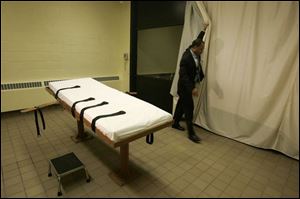
Ohio asked to suspend executions
9/25/2007
A state employee shows the death chamber at the Southern Ohio Correctional Facility in Lucasville in 2005. The report said Ohio is 3.8 times more likely to impose the death sentence on the killer of a white victim than on a killer of a black person.
COLUMBUS - An American Bar Association study yesterday urged Gov. Ted Strickland to immediately halt executions in Ohio until the state fixes flaws in a system it characterized as unfair and inequitable.
"Ohio is included because Ohio is a leader in this country politically and in many other ways," said Michael S. Greco, past president of the national lawyer organization. "We wanted to bring to the attention of the people of Ohio, the leadership of Ohio in every branch, the fact that Ohio like other states is not meeting standards. If Ohio can take a leadership step, we think other states would listen and look to Ohio's example."
No promises were forthcoming from Mr. Strickland, a Democratic governor and former prison psychologist who has allowed two executions to proceed during the first months of his administration.
"The governor supports the death penalty," said spokesman Keith Dailey. "He believes certain members of society commit acts so heinous that the death penalty or capital punishment is warranted. Given that the governor is knowledgeable of the system, he thinks it's fair, but he will carefully review this report."
Among those on the 10-member Ohio Death Penalty Assessment Team were such notables as former Ohio Supreme Court Justice Craig Wright; U.S. Rep. Stephanie Tubbs Jones, a former Cuyahoga County judge and prosecutor; state Sen. Shirley Smith, who has pushed her colleagues without success to sanction a similar study; U.S. District Court Chief Magistrate Michael R. Merz from Dayton; Geoffrey S. Mearns, a Cleveland-Marshall college of law professor who assisted in the prosecution of Terry Nichols in the Oklahoma City bombing, and several defense attorneys and law professors.
Magistrate Merz and Mr. Mearns were the only members of the committee who abstained from what was otherwise a unanimous vote of the Ohio-specific committee on seeking a moratorium on executions.
Ohio has carried out 26 executions since it resumed carrying out the death penalty in 1999, most recently in May.
Among other issues, the team found Ohio is 3.8 times more likely to impose the death sentence on someone who kills a white victim than on a killer of a black person; does not take adequate steps to preserve DNA evidence while an inmate remains on death row, fails to record police interrogations, fails to take sufficient steps to prevent faulty lineup identifications, and provides inadequate pay to attract quality attorneys for indigent defendants.
It also found a geographic imbalance, noting that someone convicted of murder in Hamilton County is much more likely to be sentenced to death than in Cuyahoga County.
"Despite the best efforts of a multitude of principled and thoughtful actors who play roles in the criminal justice system in the state of Ohio, our research established that at this point and time, the state of Ohio cannot ensure that fairness and accuracy are the hallmark of every case in which the death penalty is sought or imposed," reads the study.
Ohio is the seventh state whose death penalty processes have been studied by the ABA since 2003.
The organization had previously called for moratoriums in Alabama, Georgia, Indiana, and Tennessee. While finding that Arizona and Florida did not meet ABA standards, the committees that studied those states stopped short of seeking moratoriums.
A similar study of Pennsylvania's system is anticipated in coming weeks. Absent from the list is Texas, which carries out more executions than any other state in the nation.
"It's a hatchet job on our death penalty statutes, totally unjustified," said John Murphy, spokesman for the Ohio Prosecuting Attorneys Association. "If there's one person identified as being a prosecution person, it's still heavily weighted the other way. It's a wish list for defense lawyers."
Phyllis Crocker, professor at Cleveland-Marshall college of law and chairman of the assessment team, said members were never asked their personal views on the death penalty and, as a result, there was no effort to create a philosophical balance on the committee.
"I am optimistic. I'm also realistic," said Jim Tobin of Ohioans to Stop Executions. "We're now entering an election season, so I'm not kidding myself that the legislature or the governor is going to go right out [and champion a moratorium]. But we've been waiting for this kind of evidence for the people of Ohio, whether you want to criticize the makeup of that committee or not, that at least somebody else is saying we've got problems. And the people who are saying it, I think, are actually involved in the day-to-day operations of the death penalty."
The report took particular aim at the state Supreme Court, contending it has not played a role in determining whether the death penalty has been imposed proportionately in similar crimes. Ohio Supreme Court Chief Justice Thomas Moyer said the report is complex and "draws sweeping conclusions.''
"The adjudication of capital cases is one of the most serious responsibilities of the criminal justice system," he said. "While the Supreme Court of Ohio was not consulted in the preparation of this 500-page report, we will be reviewing its findings and conclusions thoroughly."
Contact Jim Provance at:
jprovance@theblade.com
or 614-221-0496.